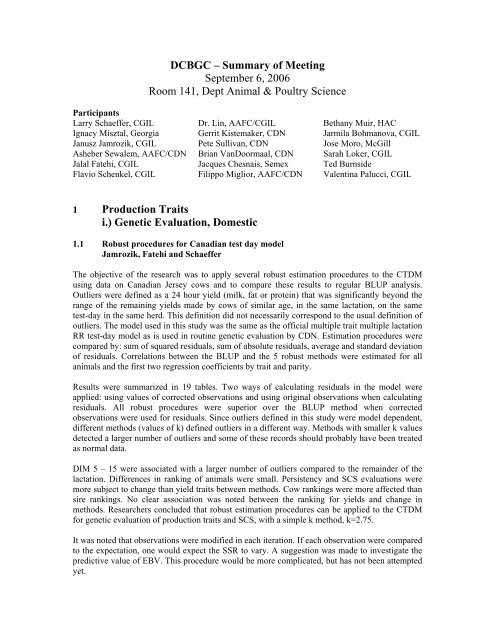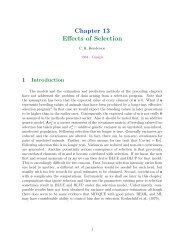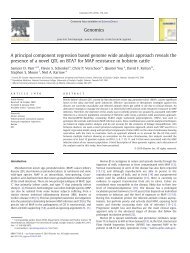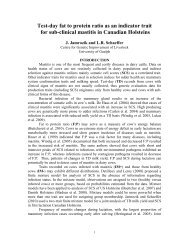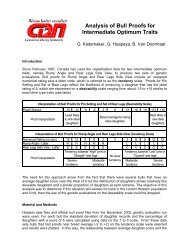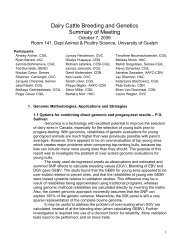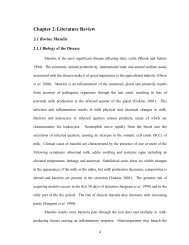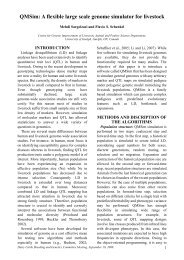September 2006 - CGIL
September 2006 - CGIL
September 2006 - CGIL
Create successful ePaper yourself
Turn your PDF publications into a flip-book with our unique Google optimized e-Paper software.
Participants<br />
Larry Schaeffer, <strong>CGIL</strong><br />
Ignacy Misztal, Georgia<br />
Janusz Jamrozik, <strong>CGIL</strong><br />
Asheber Sewalem, AAFC/CDN<br />
Jalal Fatehi, <strong>CGIL</strong><br />
Flavio Schenkel, <strong>CGIL</strong><br />
DCBGC – Summary of Meeting<br />
<strong>September</strong> 6, <strong>2006</strong><br />
Room 141, Dept Animal & Poultry Science<br />
Dr. Lin, AAFC/<strong>CGIL</strong><br />
Gerrit Kistemaker, CDN<br />
Pete Sullivan, CDN<br />
Brian VanDoormaal, CDN<br />
Jacques Chesnais, Semex<br />
Filippo Miglior, AAFC/CDN<br />
1 Production Traits<br />
i.) Genetic Evaluation, Domestic<br />
1.1 Robust procedures for Canadian test day model<br />
Jamrozik, Fatehi and Schaeffer<br />
Bethany Muir, HAC<br />
Jarmila Bohmanova, <strong>CGIL</strong><br />
Jose Moro, McGill<br />
Sarah Loker, <strong>CGIL</strong><br />
Ted Burnside<br />
Valentina Palucci, <strong>CGIL</strong><br />
The objective of the research was to apply several robust estimation procedures to the CTDM<br />
using data on Canadian Jersey cows and to compare these results to regular BLUP analysis.<br />
Outliers were defined as a 24 hour yield (milk, fat or protein) that was significantly beyond the<br />
range of the remaining yields made by cows of similar age, in the same lactation, on the same<br />
test-day in the same herd. This definition did not necessarily correspond to the usual definition of<br />
outliers. The model used in this study was the same as the official multiple trait multiple lactation<br />
RR test-day model as is used in routine genetic evaluation by CDN. Estimation procedures were<br />
compared by: sum of squared residuals, sum of absolute residuals, average and standard deviation<br />
of residuals. Correlations between the BLUP and the 5 robust methods were estimated for all<br />
animals and the first two regression coefficients by trait and parity.<br />
Results were summarized in 19 tables. Two ways of calculating residuals in the model were<br />
applied: using values of corrected observations and using original observations when calculating<br />
residuals. All robust procedures were superior over the BLUP method when corrected<br />
observations were used for residuals. Since outliers defined in this study were model dependent,<br />
different methods (values of k) defined outliers in a different way. Methods with smaller k values<br />
detected a larger number of outliers and some of these records should probably have been treated<br />
as normal data.<br />
DIM 5 – 15 were associated with a larger number of outliers compared to the remainder of the<br />
lactation. Differences in ranking of animals were small. Persistency and SCS evaluations were<br />
more subject to change than yield traits between methods. Cow rankings were more affected than<br />
sire rankings. No clear association was noted between the ranking for yields and change in<br />
methods. Researchers concluded that robust estimation procedures can be applied to the CTDM<br />
for genetic evaluation of production traits and SCS, with a simple k method, k=2.75.<br />
It was noted that observations were modified in each iteration. If each observation were compared<br />
to the expectation, one would expect the SSR to vary. A suggestion was made to investigate the<br />
predictive value of EBV. This procedure would be more complicated, but has not been attempted<br />
yet.
There seemed to be no clear relationship between the percentage of daughters with modified data<br />
and the ranking of sires. A question was posed as to whether it would be possible to apply a<br />
different method for outliers to yield traits than to SCS, since there tended to be more erroneous<br />
yield data compared with SCS. This method would be possible, but one would always have to<br />
keep in mind that there is a built-in correlation structure between the 4 traits in the model.<br />
DHI manipulates and screens data before sending it to CDN for inclusion in genetic evaluation. In<br />
addition, they also place holds on records until the subsequent test so that outlying records from<br />
the previous test can be validated. Record screening is only performed on yield traits, not on SCS.<br />
It was noted that this screening is only performed on a cow-to-cow comparison, not cow-to-herd<br />
basis. It was estimated that DHI screens approximately 3-5% of the records for inclusion in<br />
genetic evaluation. Calculating the percentage of records expected to be outliers would not easy<br />
since outlying records are defined by DIM and are specific to each cow and her predicted<br />
lactation curve. Producers are aware of DHI’s editing process so it is no longer beneficial to<br />
attempt to manipulate yields on one test day. This manipulation must be constantly conducted in<br />
order to go unrecognized. Due to owner-supervised testing, it is no longer beneficial to<br />
manipulate owner tests, since supervised tests will tend not to pass the editing process and be<br />
removed every time.<br />
Breeding Values are accounted for with the robust procedure, animals therefore animals that are<br />
outliers because of their superior genetics would not be discounted. The adjustment for<br />
heterogeneous variance and robust estimation procedures are interconnected. If heterogeneous<br />
adjustments were performed prior to estimation, then fewer outliers would be expected. It is<br />
possible to have a different k value for different traits.<br />
1.2 Phantom Genetic Groups and Genetic Trend<br />
Schaeffer<br />
At the previous technical meeting, the possibility of smoothing the effects of phantom genetic<br />
groups was proposed. In this study, a small (non-species specific) population was simulated to<br />
investigate the effects of different genetic grouping methods. Eight generations of selection (for<br />
two correlated traits) and matings were performed. Missing parents were randomly assigned,<br />
therefore results from this study mat not be as bias as they might be in the actual dairy cattle<br />
population. Four different models were investigated; a simple animal model, a model that<br />
included a year of birth effect, a model including phantom parent groupings, and lastly a model<br />
that included year of birth effects and phantom parent groupings. Three different percentages of<br />
unknown parents (0%, 10% and 25%) were simulated for each model. Variance components,<br />
breeding values and genetic trends were estimated.<br />
Correlations between the true BV and estimated BV were calculated. Only small differences<br />
between models were realized. The highest correlation was found for the simple animal (without<br />
year of birth effects or phantom groups). As the percentage of unknown parents increased, the<br />
correlation decreased. When year of birth effects are added to the model, unknown parents cause<br />
problems in estimating breeding values.<br />
Average inbreeding coefficients for animals born were summarized. As the percentage of<br />
unknown parents increased, the inbreeding coefficient decreased. Therefore when an increasing<br />
amount of the pedigree was missing, the inbreeding rate was significantly underestimated. No<br />
statistical differences between models were found when comparing genetic and residual variances<br />
and heritability. The simple animal model gave unbiased estimation for all pedigree structures.
Therefore, one can assume that phantom groups can be ignored under any pedigree structure.<br />
True and estimated genetic trend were compared. The basic animal model (no year of birth or<br />
phantom group effects included) always underestimated the true genetic change in the population,<br />
and bias increased as the percentage of unknown parents increased. Genetic average by<br />
generation shows that bhat solutions did not match true genetic change. If one investigates the<br />
phantom parent group solutions for one replicate one can see that they are not smooth and are<br />
quite large and do not follow true genetic change. Researchers concluded that phantom group<br />
solutions do not have to follow genetic trend, and that year of birth effects should be included in<br />
the estimation model. If phantom group solutions are smoothed, problems will be encountered.<br />
A concern was raised that since this was a small generic data set that the results and conclusions<br />
would not have a practical application. Since only a single sample was generated, we would not<br />
expect the phantom group solutions to be smooth. If several runs were performed and results were<br />
averaged, then the solutions would become smoother.<br />
The study showed that when year of birth effects were included in the model, phantom groups<br />
were not necessary. In addition, the estimated genetic parameters were not different between<br />
models, suggesting that inclusion of phantom group effects for routine estimation of parameters<br />
was not needed.<br />
Since it has been proven that phantom group solutions do not have to follow genetic trend, a<br />
proper protocol for determining groups needs to be established. The study showed the difference<br />
between approaches was negligible as long as there were enough animals in each group. When<br />
group size increased, the effects tended to smooth out, and parents of cows tended to follow<br />
patterns more than parents of bulls. Dams of cows were more likely to be missing compared to<br />
sires of bulls. If a sire of a bull were missing, it would tend not to be an animal that would be<br />
highly used in the population.<br />
Internationally, pathways (SD, DD, SC, DC) have different levels of missing information. The<br />
results of this study show that the solutions for DC increase by year, but only represent 1/3 of the<br />
true genetic change. Number of animals included in the groups would only be an issue under the<br />
assumption of fixed phantom groups; under a random effect assumption, the size of the group<br />
does not matter.<br />
1.3 Effect of Pregnancy on Milk Yield of Canadian Dairy Cattle<br />
Bohmanova, Miglior, Kelly, Kistemaker and Locker<br />
Preliminary results for updating the TDM were presented. The objectives of the current study<br />
were to evaluate effect of pregnancy on milk production using test-day milk yield and<br />
insemination records. Data were from all seven dairy breeds. Only results from Holstein, Ayrshire<br />
and Jersey were summarized in the report. Two models were compared, one with an effect of<br />
days open (12 classes) and one with an effect of stage of pregnancy (9 classes). In order to<br />
validate third lactation information, a fourth calving had to be confirmed. Detailed insemination<br />
data were only uniformly available after 1996.<br />
Effect of days open on lactation curves was consistent across breeds. Overall yield was lowest for<br />
cows that were never pregnant and as cows stayed open longer, milk production increased. Effect<br />
of days open seems to be confounded with the production level of the cow. Pregnancy effects<br />
were almost negligible at beginning of lactation and became more important as lactation<br />
progressed. The magnitude of decline in milk production as pregnancy progressed was larger than
eported in other studies. In addition to the effects of pregnancy this drop in milk production was<br />
confounded by effect of DIM.<br />
It was noted that more than 35% of the cows were found to never become pregnant in first<br />
lactation, which was an expected result. However, 60% of the cows were recorded as not yet<br />
becoming pregnant when the test was taken. This percentage was expected to be closer to 30%.<br />
Cows coded as not becoming pregnant until after 310 days in milk had the highest level of milk<br />
production. Perhaps the owners of these cows chose not to inseminate these cows until later in<br />
lactation because they were high producers. A suggestion was made to graph the decline of milk<br />
production in terms of percentage of yield rather than by kilograms of yield so that the decrease<br />
can be compared across breeds. In addition, estimation of the interaction between stage of<br />
lactation and stage of pregnancy was recommended.<br />
2 CONFORMATION TRAITS, i. Genetic Evaluation (Domestic)<br />
2.1 Table showing if Fixed or Random contemporary group was included in analysis<br />
This table was given to the committee for reference, but was not discussed.<br />
2.2 Approximate Reliability Patch for Conformation<br />
Sullivan and VanDoormaal<br />
CDN started providing Parent Averages (PA) for animals whose index or proof could not be<br />
calculated. Due to some inconsistencies between reliabilities calculated in February and those<br />
calculated in May (specifically unexpected drops in reliabilities), a review of the reliability<br />
approximation procedure used in the new type system was initiated. Researchers found no errors<br />
in the methodology, but rather an issue with how the approximation was designed. Drops in<br />
reliability from one proof run to the next, although theoretically possible, could cause problems<br />
with extension. Therefore, it was decided to modify the procedure to ensure that the PA reliability<br />
never went down.<br />
The modification (or patch) substituted the matrix of Tier and Meyer with one that accounted for<br />
knowing sire and dam were mates in the parent contribution of the approximation algorithm. In<br />
this case, the parent contributions to reliability were corrected to be a maximum of 50% (rather<br />
than 40%).<br />
Changes in reliability between the old and new approximation procedures were summarized.<br />
Changes were small for animals with either low or high reliability. Animals with originally<br />
intermediate reliability (20-60%), which would be mostly based on parent information, changed<br />
by 2 to 3 percentage points. After the patch was applied, reliabilities only increased as desired.<br />
Changes in reliabilities between procedures were smaller if old reliabilities were high.<br />
Researchers concluded that extension problems related to decreases in parent average reliabilities<br />
would have mostly applied to animals that did not have contemporaries for their first official<br />
evaluation, since their own performance record would not contribute to the reliability. Small<br />
contemporaries are less common in production evaluations. Therefore, investigation into applying<br />
a similar patch to the reliability approximation procedure for production traits was not suggested.
There was a general concern that reliabilities tend to be overestimated and that warranted further<br />
investigation. The patch was implemented in August.<br />
2.3 Including Reclassifications after 1 st Lactation in Genetic Evaluation<br />
Sullivan, Kistemaker and Van Doormaal<br />
Prior to May <strong>2006</strong>, only first classifications in first lactation were included in calculation of bull<br />
evaluations for type and the most recent classification was included for calculation of cow<br />
indexes. Currently, all first lactation classifications (FIRST) are included for calculation of both<br />
indexes and proofs (one data set). Cow indexes were significantly inflated in the previous system,<br />
because only the most recent classification was included but compared to her contemporaries<br />
when she was first classified. Under the current system (using all first lactation classifications)<br />
some over-inflated cow indexes dropped significantly. In addition, cows that were never<br />
classified in first lactation lost their index. Bull proofs were only minimally affected. This study<br />
was conducted to investigate the inclusion of all classifications (ALL) or the cow’s most recent<br />
classification in addition to all her first lactation classifications (LATEST) for genetic evaluation.<br />
A majority of classification data was recorded in first lactation. The evaluation model included an<br />
effect of age*stage*time, an interaction for type of record (first or re-classification) in first or<br />
later lactations (4 in total), and an effect of herd-round-classifier.<br />
Correlations between bull proofs under the FIRST and LATEST methods were high for all traits.<br />
No difference in bull proofs was noted between the LATEST and ALL methods. Average<br />
changes in conformation EBV were essentially zero. Approximately half of the cow indexes and<br />
bull proofs for conformation did not change moving from the FIRST to the LATEST or ALL<br />
methods. Of those proofs or indexes that changed a majority changed by plus or minus 1. Range<br />
in change for cow indexes was slightly larger than for bull proofs. Proofs of bulls who had<br />
daughters that reclassified did not change more than proofs of bulls that did not have reclassified<br />
daughters, moving from the FIRST to the LATEST method. As the percentage of daughters<br />
reclassified increased, the reliability of the bulls proof increased more (~2.5).<br />
Differences between proofs changing from the FIRST to LATEST and FIRST to ALL methods<br />
were not large. When a high percentage of daughters were reclassified reliabilities increased more<br />
under the ALL method (to a maximum of ~5) compared to that under the LATEST method. As<br />
the number of reclassifications increased so did the reliability of the cow indexes switching to the<br />
LATEST or ALL methods. In some cases, average change in reliability of cow indexes was an<br />
increase of 30%. Cows that originally scored higher tended to have greater increases in EBV due<br />
to their reclassification in a later lactation. Cows with higher scores were the only cows<br />
reclassified multiple times in later lactations. EBVs increased the most for cows with the largest<br />
number of classifications.<br />
The average phenotype in reclassified daughters was higher compared to the rest of the<br />
population. Animals that were reclassified 6 times were more likely cows scored multiple times<br />
as being excellent. It would be interesting to compare a bull’s first proof to that once his<br />
daughters have been reclassified. All increases were assumed to be genetic. Permanent<br />
environmental variance should be substantial and were not estimated or accounted for under the<br />
proposed model. However, if a permanent environment and frequency of reclass effect was<br />
included in the model, essentially no genetic change would be realized.<br />
Under the new classification system, animals that are presented for classification but not rescored<br />
and raised can be accounted for. The possibility exists that bias was introduced because
classification scores can only increase may partially be removed if a management effect of<br />
percent of animals presented to for a raise can be included.<br />
Concerns that animals were not receiving indexes due to the requirement that a fist lactation<br />
classification be recorded are avoided if the LATEST method is chosen. However, under the<br />
LATEST method, only the most recent reclassification is used if an animal was classified several<br />
times after first lactation. In this way, animals would be removed from contemporaries from<br />
classifications previous to her latest (in later lactations). The remainder of the contemporary<br />
would be reshuffled and as a result EBVs of the remaining contemporary may increase or<br />
decrease just from that one animal being removed. This situation would not occur under the ALL<br />
method, when all classifications would be used and therefore animals would not have to be<br />
removed from contemporary groups.<br />
Clearly the ALL method should be selected over the LATEST method for this reason. If the ALL<br />
method does not pass the trend validation, then the LATEST method should be investigated<br />
further. The possibility of assuming a non-zero permanent environmental variance for the<br />
calculation of reliabilities was suggested to keep the reliabilities from being inflated with a large<br />
number of reclassifications.<br />
There is a computational benefit to having cow and bull evaluations calculated from the same<br />
dataset. As long as cow reliabilities can be kept from increasing too much this would be a<br />
preferred methodology. Perhaps there should be a limit placed on the amount of information later<br />
classifications can contribute to the reliability calculation.<br />
CDN will perform trend validations for Interbull and calculate stability of proofs under the ALL<br />
method. Results will be presented to the Genetic Evaluation Board at the end of <strong>September</strong>.<br />
3 AUXILIARY TRAITS<br />
i.) Survival, Longevity<br />
3.1.1 Relationships Between Reproduction Traits and Functional Longevity in Canadian<br />
Dairy Breeds<br />
Sewalem, Kistemaker, Miglior, Van Doormaal<br />
This research was a continuation of previous studies that reported relationships between type<br />
traits and longevity. Relationships between calving and fertility traits and longevity were<br />
investigated in the Ayrshire, Jersey and Holstein breeds. A proportional hazards model and<br />
survival kit were used. Animals that had calvings requiring a hard pull or surgery were more<br />
likely to be culled. Animals having small or large calves were more likely to be culled than<br />
animals having medium sized calves. Since the risk of culling was only minimally higher for<br />
large calves compared to medium calves, one should caution making strong conclusions about<br />
this relationship.<br />
Relative risk for culling was highest for animals giving birth to dead calves. As number of<br />
insemination services increases so did the relative risk of culling. Relationships between calving<br />
traits and longevity were stronger than between fertility traits and longevity. The significant<br />
relationship between stillbirth and culling rates was surprising, however, stillbirth was not<br />
analyzed independently from calving ease. Dead calves can result from infections, calving<br />
difficulties and many other factors.
3.1.2 Analysis of Stillbirth Rates (direct and maternal) in Canadian Holsteins<br />
Van Doormaal and Brand<br />
Interest in rates of stillbirth continues to grow. As a result, CDN performed an analysis to<br />
describe differences between maternal and direct stillbirth rates in first and later lactations. In<br />
most recent years, stillbirth rates in first lactation increase to 12% compared to a steady trend of<br />
10% in past years. Later lactation stillbirth rates have continued to increase steadily from 4% to<br />
6% since 2000.<br />
In most recent birth years of sires, maternal stillbirth rates were higher. Distribution of first<br />
calving direct stillbirth rates have not changed from 1992-1994 compared to 2001-2003.<br />
Distribution of first lactation maternal stillbirth rates has shifted to the right. The correlation<br />
between maternal stillbirth rates in first and later lactations was estimated to be 60%. Bulls with a<br />
high maternal stillbirth rate based on first lactation were expected to have high rates for stillbirth<br />
rates for later calvings. In previous reports, the genetic correlation between first and later calving<br />
stillbirth rates was estimated to be 30%. The correlation between direct and maternal stillbirth<br />
rate in first lactation was estimated to be 41%.<br />
Bulls having high maternal stillbirth rates were investigated too see if this problem ran in certain<br />
bloodlines. Bulls such as Bellwood, Rotate and Marshall were found to be undesirable. Bulls such<br />
as Blackstar, Starbuck and Aerostar were found to have desirable rates for maternal stillbirth.<br />
Hopefully this analysis raises huge interest to have maternal and direct stillbirth breeding values<br />
calculated and will create an awareness of a potential problem in certain bloodlines.<br />
ii. Fertility<br />
3.2.1 Characterization of Body Condition Scores in Canadian Dairy Cattle<br />
Monardes, Cue and Moro-Mendez<br />
A visiting scientist from McGill presented results from ongoing research with Body Condition<br />
Score (BCS) in Québec herds. Objectives of the study were to characterize BCS recorded under<br />
commercial conditions and to assess the importance of certain environmental effects on BCS. In<br />
Québec, BCS is recorded by producers and collected by Valacta technicians on test day.<br />
Approximately half of the cows in each parity had only one record of BCS and over 30% of the<br />
records were recorded before 60 DIM. Observations were analyzed as repeated records by cow<br />
using a classification model and a Wilmink model for Ayrshire and Holstein separately in each of<br />
the first 5 lactations.<br />
Average BCS in Holsteins was lower than 3.00 in all parities, and average BCS in Ayrshires was<br />
generally higher than that in Holsteins. First lactation Holsteins tended to have higher average<br />
BCS if they calved at an older age. BCS curves tended to mirror lactation curves and were of<br />
generally the same shape in Holsteins and Ayrshires. Loss of BCS from DIM 1 to 60 ranged from<br />
0.24 units in first lactation to 0.44 units in third lactation. After 60 DIM, BCS increased in each<br />
lactation.<br />
A suggestion was made to plot Wilmink curves for every lactation (by breed) on the same graph<br />
in order to clearly see differences in shape of curves across lactations. In addition, and interaction<br />
of herd-year-month was suggested for inclusion in the model. Researchers should consider a<br />
variance adjustment by herd in order to account for differences in producer scoring methods
scoring. In addition, investigation of a random regression test day model or adjusting BCS for<br />
level of production was suggested. Data being collected by Holstein Canada and Valacta should<br />
be merged and analyzed jointly. Research on the calculation of genetic parameters continues.<br />
iii. Health Traits<br />
3.3.1 Health Traits: Combining Veterinary Data from DS@HR and CDN/Valacta<br />
Cue and Moro-Mendez<br />
The feasibility of merging information on health events recorded by Québec veterinarians<br />
(DS@HR) with those collected by milk recording (Valacta) is being investigated. Data structures<br />
and file layouts were provided. Attempting to match records required merging calving dates<br />
provided by CDN. Approximately 60% of the records matched. Over 157K Holstein and 8.3K<br />
Ayrshire records were available. Further large-scale combination of data will require significant<br />
data editing.<br />
Concern was raised over the different ways events are recorded between Ontario and Québec. All<br />
terminology will be based on the current DS@HR system. Therefore, links to other system<br />
terminology need to be established. To be efficient, researchers should attempt to fit this data<br />
with specifications for Dr. Schaeffer’s proposed model for genetic evaluation of health traits.<br />
3.3.2 Multiple Trait Test Day Model for Health Traits in Dairy Cattle<br />
Schaeffer<br />
A research proposal was submitted to DairyGen to investigate a multiple trait, linear test day sire<br />
model for the analysis of 24-hr milk yields, somatic cell scores, body condition scores and nine<br />
health traits. A summer student, Shannon Cartwright, provided a literature for the proposal.<br />
Model effects include; stage of lactation, gestation length prior to that lactation, calving ease<br />
score, year and month of calving, age*parity, interactions, herd-test-day-parity, sire and cow<br />
within sire. If an animal experienced a disease after the associated test date, it received a 1, and if<br />
no disease event was recorded the animal received a 0. If a disease occurred more than once<br />
between test days, only the first occurrence was recorded. The model assumed that each animal<br />
had milk yield, SCS and BCS recorded and was observed for all nine health traits on every test<br />
day. Therefore, missing data on a test date were not allowed.<br />
To begin with, the height of lactation curve or mean levels of disease occurrence will be<br />
estimated for sires. Since calving ease and BCS will be included as covariates, reduction of the<br />
genetic variation in disease traits is not expected. Cows with more than one disease can be<br />
included and subsequently correlations between the disease traits can be estimated.<br />
Currently, BCS is only collected in Québec herds on test day by milk recording technicians,<br />
however, in the future, this requirement may become mandatory across Canada. In June, Holstein<br />
Canada began classifying animals for BCS on classification day. BCS recorded on classification<br />
day may not be ideal because the event is best recorded before and after calving.<br />
The collection system for health and disease traits will focus on 8 of the most prevalent traits.<br />
Data will be a combination of farmer-recorded events, events collected by veterinarians or by<br />
DHI or on-farm data management systems. Since the proposed model is a sire model, cow
indexes will not be made available. Female indexes for low heritability traits with low incidence<br />
are not useful. CDN calculates female indexes for every trait, but not all are published.<br />
A suggestion was made to measure the occurrence of disease in the month when it is most likely<br />
to occur. If diseases that are more likely to occur in the first month of lactation, assessing the<br />
occurrence of that disease over the entire lactation may disable detection of differences between<br />
sires during the most frequent times. Attempts to analyze health data using a random regression<br />
model have given strange results in previous studies. Other suggestions were to include<br />
fat/protein ratio together with 24 milk yield and SCS, as indicator traits the model. It has been<br />
shown in literature that fat/protein ratio can be a very good indicator of certain diseases.<br />
Research can begin as soon as data are available.<br />
3.3.3 Genetic Evaluation of Health Traits in Canadian Dairy Cattle: Data Characteristics<br />
Fatehi, Schaeffer and Jamrozik<br />
The purpose of the study was to examine health data recorded by DHI and to create a usable data<br />
set for future analysis of genetic parameters and genetic evaluation. Data were recorded from<br />
1997-<strong>2006</strong>. The most frequently recorded traits were mastitis (37%), cystic ovary (14%), retained<br />
placenta (11.5%) and lameness (9.5%). Records were available for all breeds, however, 96% of<br />
the data were from Holsteins.<br />
Health events were analyzed for 5 lactations; some traits had different rates of occurrences in<br />
different lactations (i.e., cystic ovary). Parity effects in the genetic model should account for these<br />
differences.<br />
The number of animals and number of records relative to number of herds was low, since the data<br />
only included diseased animals. Subsequently, milk production on herdmates was retrieved, and<br />
the assumption was made that these relatives did not have a disease. Only test day records that<br />
qualified for genetic evaluation were included in the analysis. If the animal’s record were<br />
removed (by DHI) due to the occurrence of a disease, this information would not have been<br />
captured. Perhaps all tests, including those that do not qualify for genetic evaluation, should be<br />
included.<br />
It may not be appropriate to eliminate test day records that were less than 20 days apart. Milk<br />
recording performs surprise retests in very short intervals from scheduled tests. All tests are<br />
included in the production evaluations (TDM). If the retest shows that the first scheduled test was<br />
incorrect, then it is removed.<br />
Analyzing several traits with low incidence may be troublesome. A suggestion was made to<br />
analyze traits in larger groups. Since all traits are highly correlated, a better suggestion may be to<br />
analyze all 8 traits simultaneously. In the end, a selection index will be created using a<br />
combination of only a few traits anyways.<br />
National disease collection is scheduled to begin in April 2007.


